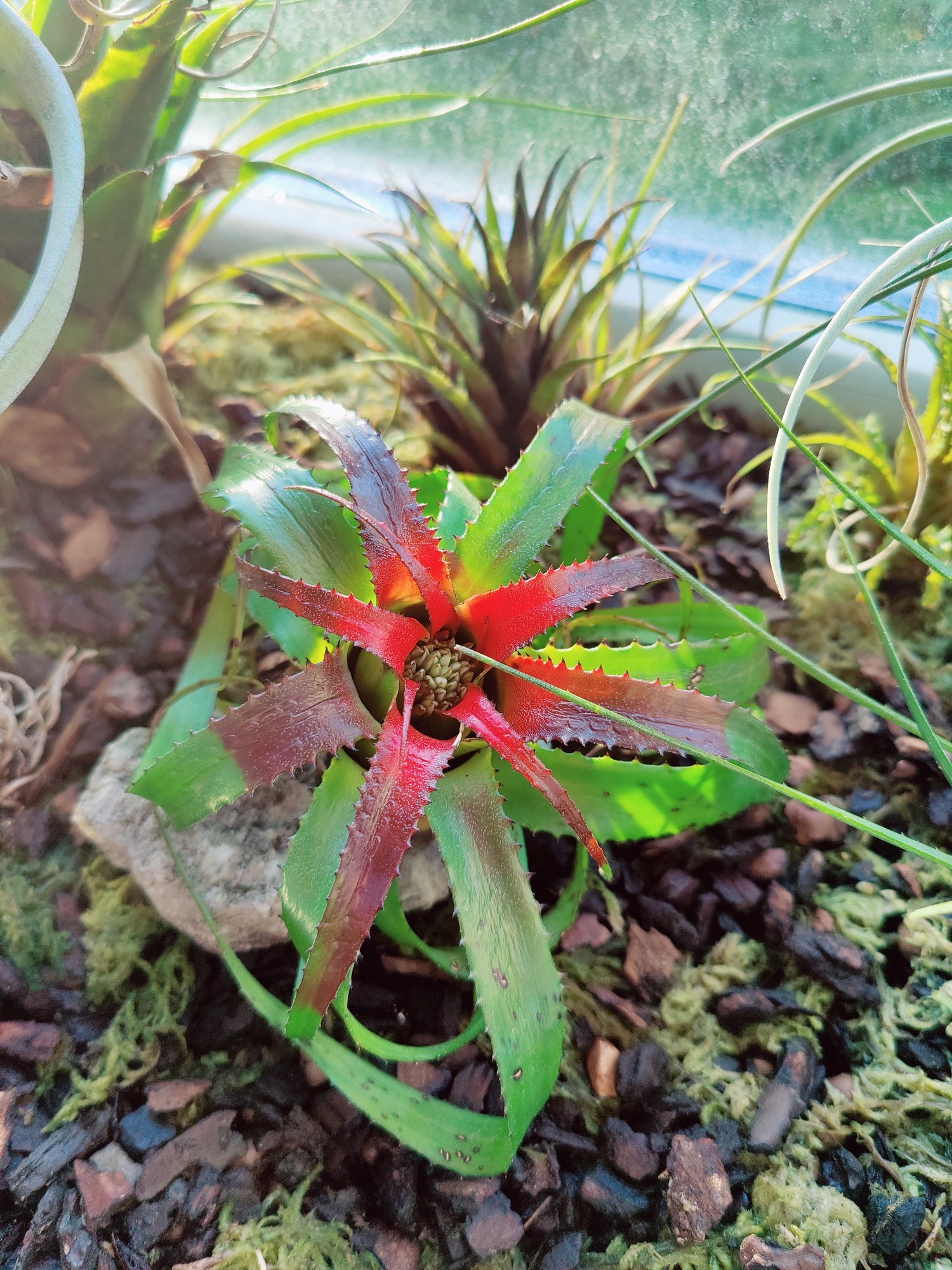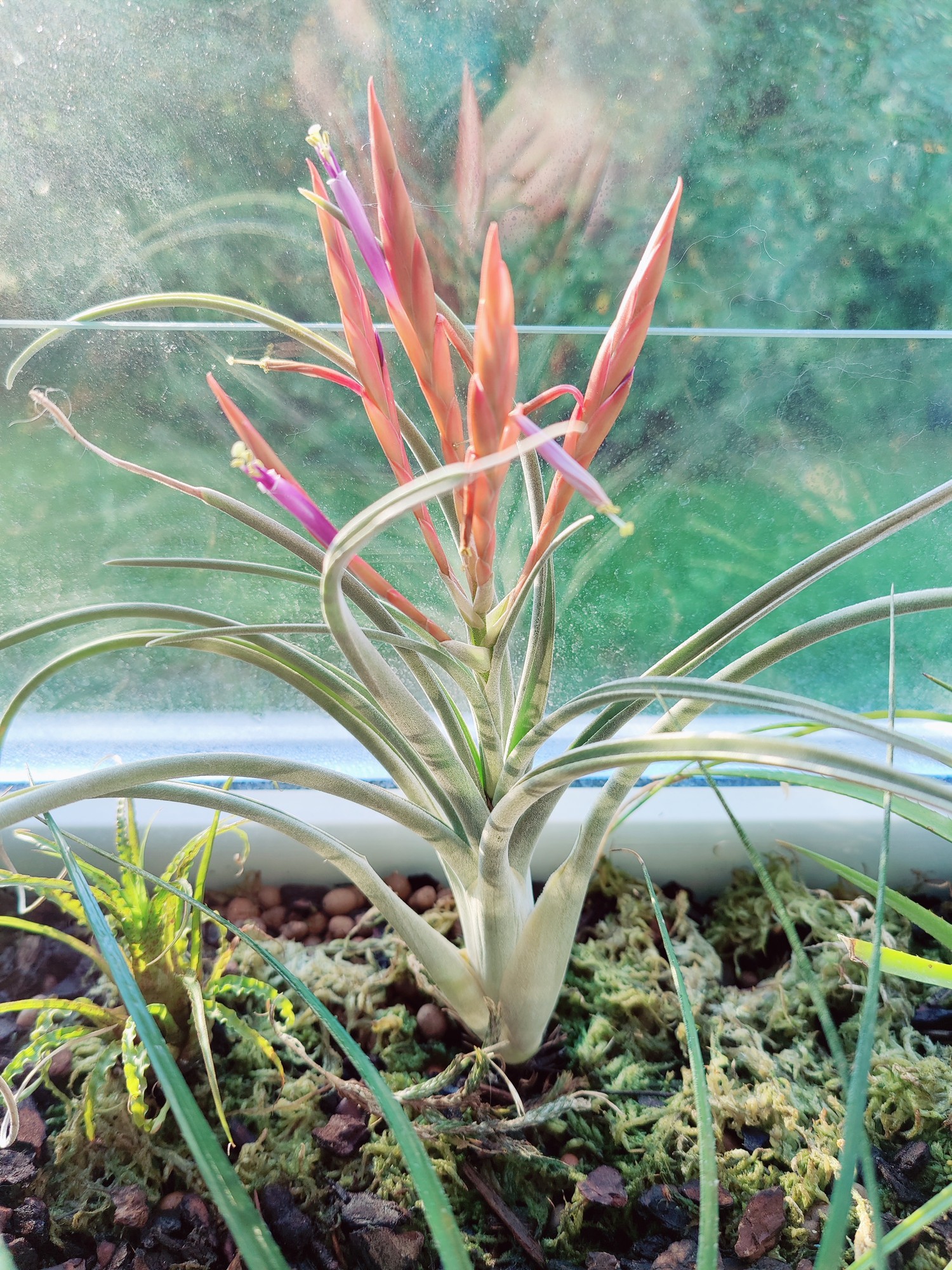No prob. Ive been doing it this way for a few years, and ive been through the full lifecycle of several species. Since im in a temperate climate i do move them outside for late spring through early autumn since there's so much rain and humidity. But the really tiny species spend their whole life in the terrarium.
Getting6409
Yep, you certainly can, though you need to take a little extra care to make sure the medium doesn't stay soupy for too long. But about once every two weeks I'll soak the terrarium floor so the water level is just about to reach the surface, but never enough to make any of the bark and stuff float, and this keeps the humidity quite high for a while. I do try and spray once a day, but with this setup they stay pretty happy even if I forget to spray for a few days.
If you're curious about the medium, it's nothing special. I just do some handfuls so that i get a mostly equal amount of orchid bark, sphagnum, and whatever those clay/lava ball rocks are. I think as long as there's not too much of anything that allows fungus or molds or other microbial life to thrive, they do well and start sending out roots and latching on to the stuff.
Not an orchid, it's a bromeliad, tillandsia, specifically. Orchid suppliers very often offer bromeliads as well since many species are epiphytes, and they generally thrive under the same kind of care.
Thanks so much for sharing this. A few months ago I was looking up these kits on ebay and was floored to see how much they go for. The pirate sets are some of my favorite and earliest memories. I remember getting the Cross Bone Clipper and playing with that thing daily for maybe two years.
Mele quieter 4c has been really good to me. I was using a celeron nuc, it worked fine, but for quiet moments in videos i could hear the fan. It wasnt obnoxious, but once i noticed it i couldnt ignore it. Mele is passively cooled and the n100 is more than adequate for 4k.
You can specify the behavior in a few places, gui, occ command, config.php. By default no, but if you have an app you want to force in regardless of the version compatibility you can make it so https://help.nextcloud.com/t/help-what-is-app-install-overwrite-for/71523
Personally, I think anyone who can should give at least one shot at home baked bread, if only to see whether or not it's something they want to do. I think for most it's going to come down to whether or not they have the time for it in their day to day, week to week, routines. If you've never tried, there's a nice recipe on youtube, first (or top 5) result when you search '5 minute baguette', by Voila. I found this to be pretty doable in a daily routine. The 5 minutes is only referring to final prep time once you got a handle on it; no matter what the dough in this recipe needs to set up for 8 hours.
Pineapples got a few words for their offshoots. I'd guess because it's a commercial fruit. I've never seen this terminology applied to offshoots/sets for other bromeliads. Other bromeliad species also send out pups from different parts of the plants. There's some tillandsias and orthophytums that make offshoots from the flowering stalk. Here's a nice diagram of pineapple offshoots and their labels
i ran this setup for years! One controller, three worker nodes, all Pi4b's. Someone mentioned that 4gb would be rather limiting; it certainly can be, but I never hit the ram ceiling. For me, disk writes and cpu were the noticeable constraint. In my first iteration I was using the fastest sandisk extreme pro whatever sd cards were at the time. My second iteration was running all hosts on usb-sata enclosures, and this was a huge improvement. I really can't recommend that route enough. If you can commit to a little cable management and maybe figure out something clean for stacking or standing the enclosures, it doesn't have to look terrible.
Regarding matching hardware, for a year I ran an old i5 lenovo thinkpad as just another worker node. It was fine, and was a pretty useful experience in running a cluster with mixed architecture. The only hiccups were those that come with a headless laptop setup. Sometimes rebooting could be dicey, stuff like that.
The only databases I was running at the time were sqlite (for the various *arrs). These would corrupt every few months, but these were not running on the sd cards, but on ssds and mounted over nfs. So yeah, don't go running sqlite over nfs.
edit: I imagine the warning about not running databases on the cards are about prematurely wearing out the cards. Seems like there are a few pi-oriented projects that lean on sqlite, though, so I'm not sure.
edit: Also just remembered that I experimented with running one node on one of those ssds that are pressed into the form factor of a usb stick. Again, sandisk extreme pro line, 128gb. I ended that after getting total freezes every few weeks. I can't say whether it was a faulty device or some incompatibility at play. I never did proper benchmarks with this against the ugreen sata usb enclosures, but it certainly did not feel any faster than the enclosures.
You could call it that. The most direct analogy is RDP, or even a kvm. It's a remote session to another machine, but under the hood it's using the fast and efficient video codecs, h264 or hevc. It's also good about piping audio from the remote machine to whatever you're using locally.
I'm also hoping to dump windows. I spent a week trying to get my usb interface working with guitar rig running in wine bottles. I was getting nowhere with it just fell back to using the windows box remotely.


I try various 1 cup recipes from time to time and I still wind up back on this one.